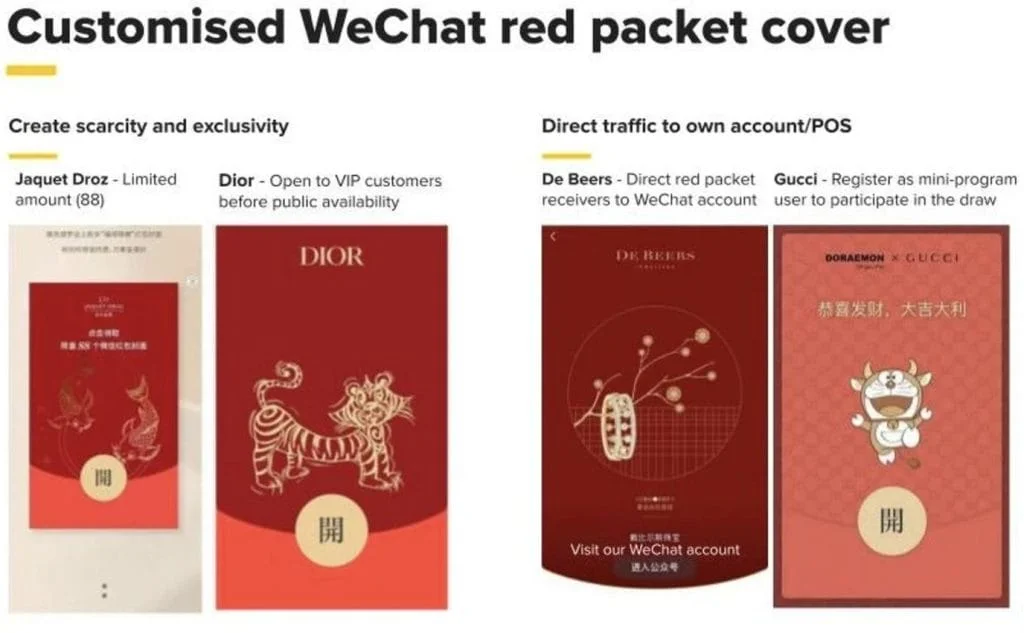All The Facts
Chinese New Year might seem far away to some, but it will come sooner than you think, so you need a Chinese marketing strategy for Chinese New Year.
In case you don’t know, Chinese New Year (hereafter referred to as CNY) is the start of a new year in the Lunar calendar. In Western Calendars, the date varies every year – but in 2024, Chinese New Year falls on Saturday, 10 February 2024.
This year will be the Year of the Wood Dragon, which is the only mythical animal in the Chinese zodiac. Chinese people always associate different attributes with each year – similar to Western zodiac signs. The official festival lasts for 15 days and ends with the Lantern Festival (24 February 2023).
How To Sell To Your Audience
Use Chinese Social Media Channels
Businesses targeting the Chinese market should consider signing up for WeChat, Weibo, and Little Red Book due to their immense popularity and unique marketing capabilities.
WeChat, with its extensive user base, offers multifunctional communication channels and in-app payment options, making it an indispensable platform for customer engagement and e-commerce. Weibo, akin to Twitter, is ideal for brand visibility and viral marketing, allowing businesses to reach millions of users with targeted content.
Little Red Book, a blend of social media and e-commerce, is especially influential among younger demographics, offering a platform for lifestyle and luxury brand promotions. Collectively, these platforms provide unparalleled access to diverse segments of the Chinese market, enabling businesses to effectively localise their marketing strategies and build a strong digital presence in one of the world’s largest economies.
A great example of this is Burberry. In previous years, they realised they wouldn’t garner the consumer attention they wanted by catering to a Western audience. The fashion house teased its Lunar New Year short-film, A New Awakening, on Weibo. The 60-second teaser garnered over 3.4 million views while the accompanying hashtag generated over 89.5 million views.
Think Outside Of The Box
Every Lunar New Year, it’s common to see a brand excessively using red and gold, lanterns, and overdone motifs, often blurring the line between cultural appreciation and appropriation. Consumers easily discern these missteps and campaign designs can often reveal the depth of a brand’s effort in their New Year marketing.
Rather, brands should genuinely integrate Lunar New Year traditions to resonate with their audience. For instance, Nike’s 2020 campaign cleverly adapted the Hongbao tradition, exchanging red packets with cash, receiving a warm reception on social media.
Craft an Innovative Marketing Campaign for Chinese New Year
Before launching typical festive marketing initiatives, remember that Chinese New Year (CNY) marketing is highly competitive, as both local and international brands vie for Chinese consumers’ attention. To make your brand shine during this significant holiday period, consider the dynamic online marketing strategy below:
Innovating with Digital Red Packets
The tradition of giving red packets during CNY is well-known, but there’s a modern twist: physical red packets are becoming passé, replaced by their digital counterparts. This change allows for instant delivery, regardless of geographical distance.
Since 2020, customised digital red packet covers, especially on platforms like WeChat, have emerged as a leading marketing trend. Renowned brands such as Hermes, Gucci, Dior, and Mont Blanc have already adopted this strategy. The appeal lies in its social and interactive qualities, minimal investment, and deep roots in cultural tradition, aligning seamlessly with online CNY celebrations.

Maximising Visibility on Short-Form Video Platforms
The dominance of short-form video as a highly consumed content format is undeniable, making it an essential component in modern marketing strategies, including those for Chinese New Year (CNY). In China, Douyin (the local counterpart of TikTok) actively encourages and supports brands in engaging with CNY-themed short video campaigns. During the festive season, social media platforms tend to prioritise CNY-related content, enhancing brand visibility and user engagement.
Creating branded CNY short videos that convey holiday greetings and your brand’s message is a common and effective tactic. For instance, BMW’s 2022 Year of the Tiger campaign serves as an exemplary model. The campaign’s widespread distribution across BMW’s social media platforms led to significant online virality, particularly among younger demographics, fostering deep engagement. This strategy resulted in an impressive 1.7 billion views on Weibo for BMW.
Exploring Livestream Shopping for Chinese New Year
In China, where livestream shopping is a significant part of the e-commerce landscape, it represents about 10% of e-commerce revenue, according to McKinsey. Its popularity soars during the Chinese New Year (CNY) period, as people are more engaged with their mobile devices. For instance, during the previous year’s CNY online shopping festival, Douyin reported a total of 90,000 hours of livestream shopping sessions, attracting a massive viewership of 467 million.
To effectively integrate livestream shopping into your marketing strategy, start by identifying products that resonate with this format. Categories like clothing, food and beverages, and household items are typically top performers. Set the stage for your livestreams with CNY-themed decorations and a red colour scheme to evoke a festive and inviting atmosphere.
For those with larger budgets, collaborating with influencers or celebrities can amplify your reach, tapping into their follower base and drawing more viewers to your channel.
To summarise, YOU NEED a Chinese New Year marketing strategy, and we at Ignite Search are just the people for it. We have a comprehensive understanding of Chinese marketing trends and platforms including Weibo, WeChat, Baidu and Little Red Book.
If you need more guidance, feel free to download our free branding worksheet, read our blog for more inspiration, or contact us for a consultation.










